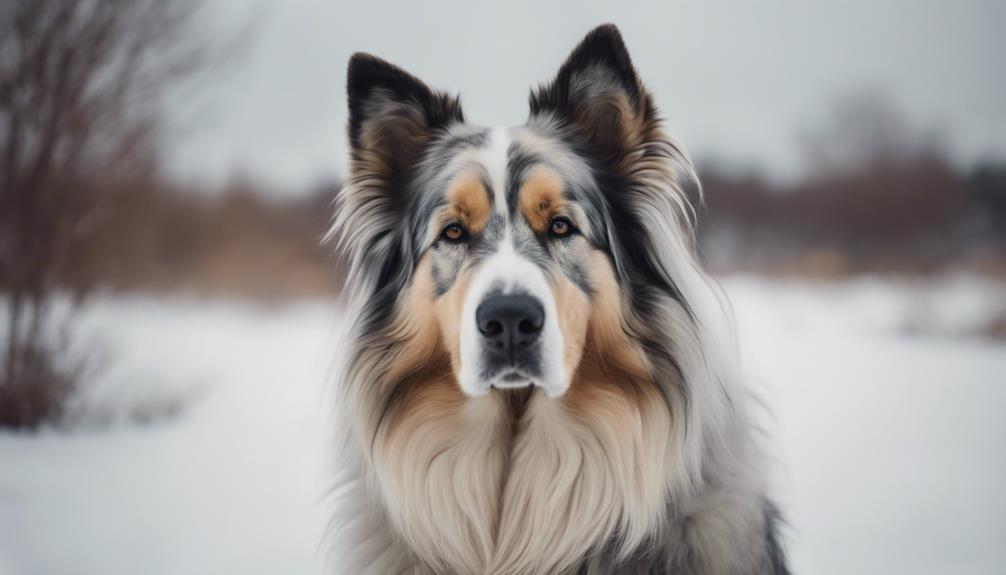🐾 Paw-some Partnership Alert! 🐾
As a pack of German Shepherd enthusiasts at MixGermanShepherd.com, we're always sniffing out the best products for our furry friends. Guess what? When you fetch something from Amazon through our links, we earn a little treat! 🦴
If you're pondering adding a new furry member to your family, the American Tundra Shepherd might just be the breed you're seeking. Their remarkable blend of strength and intelligence sets them apart from the pack. But what makes these dogs truly stand out goes beyond their physical prowess. There's a captivating history behind this breed that sheds light on their unique characteristics and abilities. It's a story that unveils the essence of the American Tundra Shepherd, making them not just pets but companions with a rich heritage waiting to be discovered.
Key Takeaways
- Developed from German Shepherds and Alaskan Tundra Wolves.
- Known for stamina, intelligence, loyalty, and alertness.
- Requires regular grooming and exercise for optimal health.
- Health concerns include hip dysplasia, cataracts, and heart diseases.
Breed Popularity and Recognition
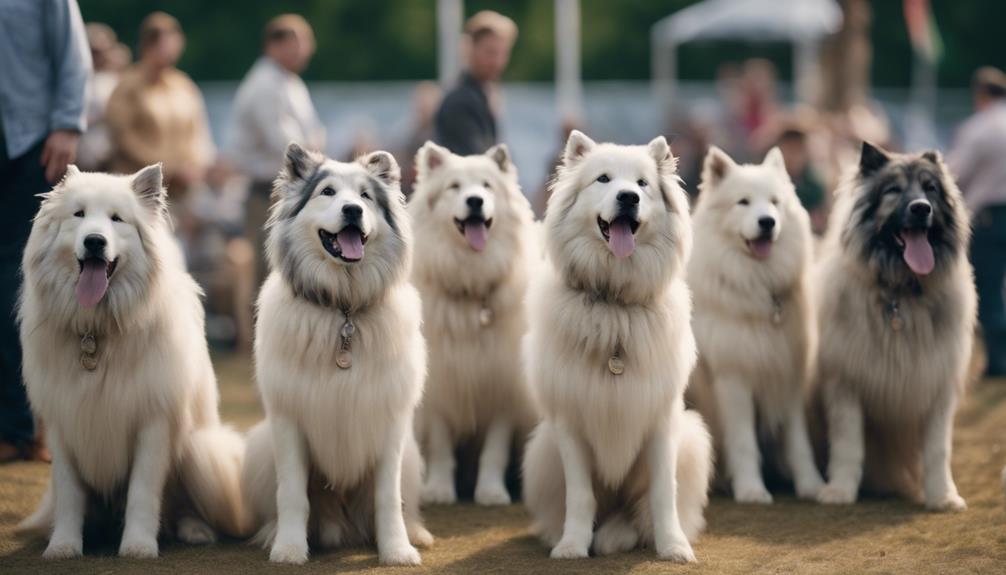
The American Tundra Shepherd breed has garnered increasing recognition and popularity due to its exceptional skills, versatility, and unique qualities. Despite being a rare breed, the American Tundra Shepherd has been gaining popularity among enthusiasts and breeders alike. This large breed stands out for its remarkable stamina, making it well-suited for physically demanding tasks. Its intelligence, loyalty, and cautiousness further contribute to its appeal, while its alertness, scenting abilities, and natural hunting instinct make it a truly versatile working dog.
The American Tundra Shepherd's development history is also a key factor in its recognition. The breed's origins lie in the combination of German Shepherds with Alaskan Tundra Wolves, resulting in a lineage that is both intriguing and functional. This unique mix has produced a dog that excels in various roles, from herding and guarding to search and rescue missions.
Physical Characteristics and Appearance
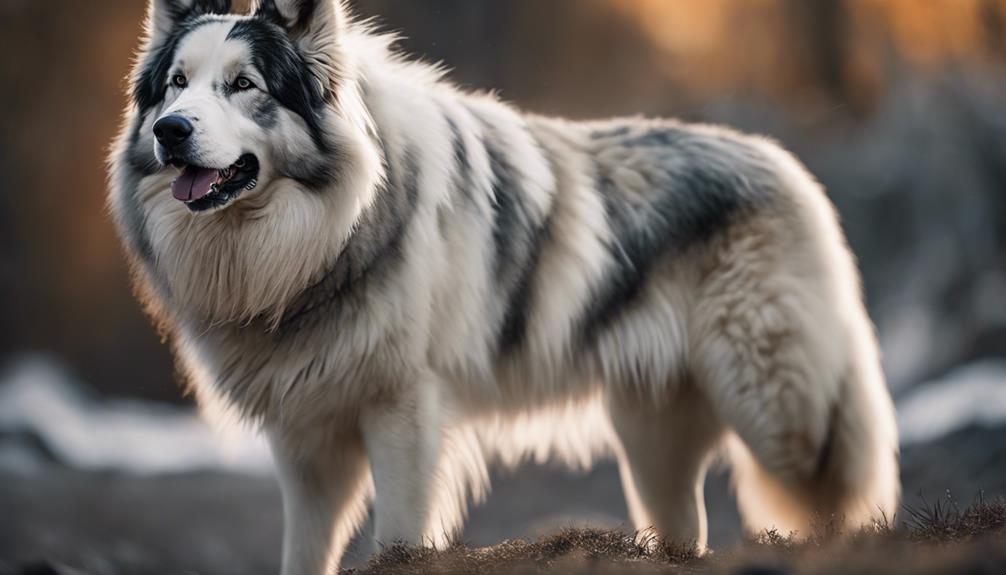
The American Tundra Shepherd's coat and color, along with its size and build, play crucial roles in defining its physical characteristics and appearance. Its double-layered coat is weather-resistant, coming in various colors such as black, grey, and white, adding to its visual appeal. The breed's sturdy frame, impressive height, and muscular physique contribute to its imposing presence and robustness, aligning with its reputation for strength and agility.
Coat and Color
With its dense, waterproof coat and varied coloration, the American Tundra Shepherd showcases a striking blend of functionality and aesthetics.
- The American Tundra Shepherd has a thick, harsh, and waterproof coat that provides protection in various climates.
- Coat colors can vary, including shades of black, gray, and white, contributing to their striking appearance.
- Their dense double coat helps regulate body temperature and provides insulation in cold weather conditions.
- The coat requires regular grooming to prevent matting and maintain the breed's distinctive appearance.
- The coat's texture and coloration reflect the breed's adaptation to its origins in colder climates, enhancing their overall rugged and wolf-like appearance.
Size and Build
In terms of physical characteristics and appearance, the American Tundra Shepherd showcases a robust build and imposing presence. This large breed typically stands between 27-33 inches tall for males, weighing 100-140 pounds, while females are slightly smaller and lighter. Their powerful stature is accentuated by a well-proportioned body, including a distinctive head and eyes that come in various striking colors. The American Tundra Shepherd's strength is evident in their robust chest, strong back, and well-developed legs, contributing to their overall appearance of agility and power. Renowned for their exceptional skills and intelligence, these dogs are well-suited for physically demanding tasks, reflecting their stamina, strength, and courage.
Temperament and Behavior Traits
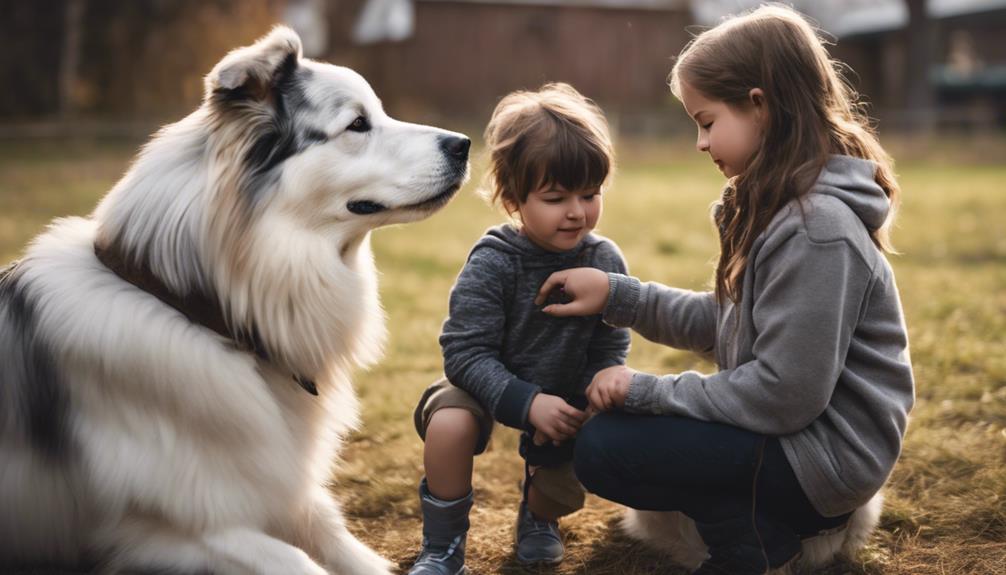
The American Tundra Shepherd's personality and disposition are marked by exceptional intelligence, loyalty, and cautiousness. This breed interacts well with children, displaying a blend of alertness and outstanding scenting abilities, making it a vigilant and protective companion. Understanding its unique traits is crucial for cultivating a harmonious relationship and tapping into its natural hunting instincts for enriching activities.
Personality and Disposition
The American Tundra Shepherd breed's personality and disposition exemplify a unique combination of exceptional intelligence, loyalty, and cautious nature. This breed showcases high alertness, exceptional scenting abilities, and a natural hunting instinct. Regular mental and physical stimulation are crucial for their well-being and happiness. With proper training, American Tundra Shepherds can develop their natural talents for physically demanding tasks. Their temperament is characterized by courage, strength, and a keen sense of responsibility towards their human family.
- High alertness
- Exceptional scenting abilities
- Natural hunting instinct
- Need for mental and physical stimulation
- Courage, strength, and sense of responsibility
Interaction With Children
Pivoting from the discussion on the American Tundra Shepherd breed's Personality and Disposition, examining their Interaction with Children reveals a harmonious blend of gentle protectiveness and intelligence in their temperament and behavior traits. This breed's loyalty and intelligence make them exceptional companions for children, demonstrating patience and understanding in their interactions. Through proper socialization, American Tundra Shepherds can develop strong bonds with children, seamlessly integrating into the family unit. Their watchful nature ensures a safe environment, as they remain alert and cautious around kids. With consistent training, their natural hunting instincts can be controlled, rendering them reliable and trustworthy in the presence of children. The American Tundra Shepherd's gentle and protective demeanor, coupled with their loyalty and intelligence, make them ideal partners for young ones.
Historical Background and Origins
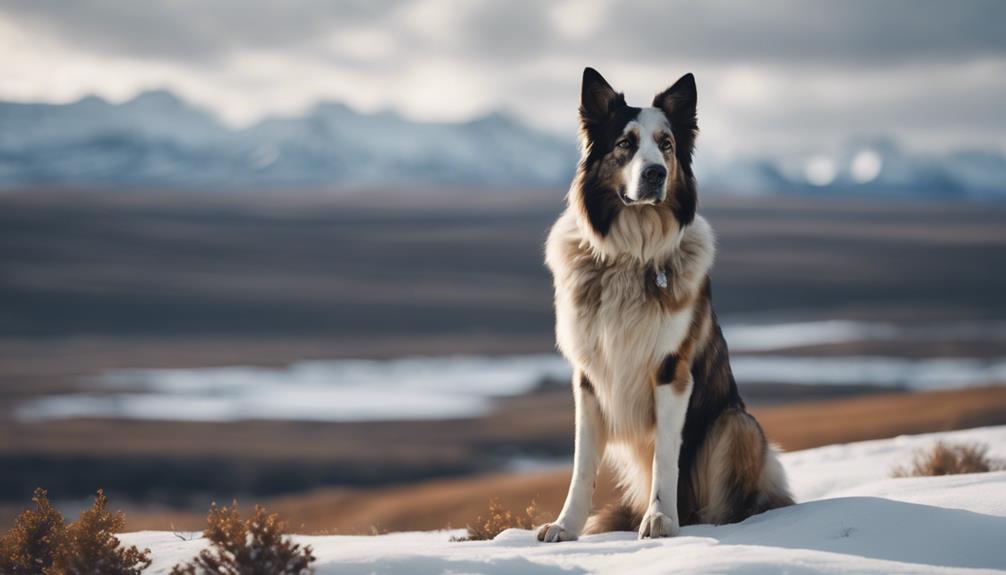
Exploring the roots of the American Tundra Shepherd breed, what pivotal events led to its creation in the late 1960s? The American Tundra Shepherd (ATS) breed was meticulously crafted by Frank Catania through the ATS Project, which aimed to develop a superior working dog. By crossing German Shepherds with Alaskan Tundra Wolves, a new breed with exceptional capabilities emerged. Here are five key points about the historical background and origins of the American Tundra Shepherd:
- Frank Catania spearheaded the breeding program that led to the creation of the American Tundra Shepherd.
- The breed's lineage can be traced back to the deliberate crossing of German Shepherds and Alaskan Tundra Wolves.
- The American Tundra Shepherd quickly gained recognition for its remarkable working abilities and adaptability.
- The ATS Project, initiated in 1968 with government funding, laid the foundation for the breed's development.
- Originally part of a military initiative seeking a healthier alternative to German Shepherds, the American Tundra Shepherd has a robust history of breeding and training, making it a standout working dog breed.
Common Health Issues and Concerns
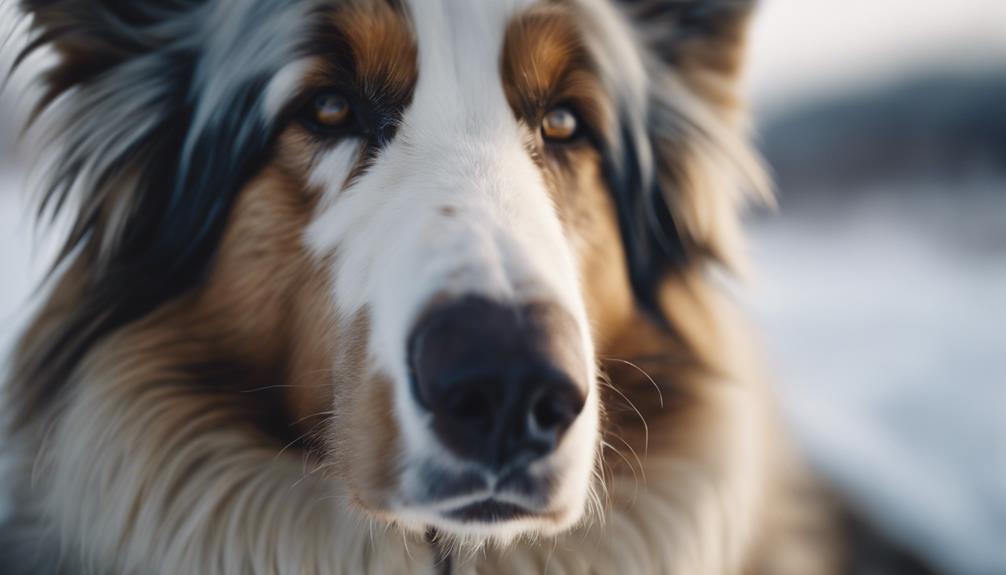
Considering the historical breeding practices that led to the creation of the American Tundra Shepherd, a comprehensive understanding of the common health issues and concerns in this breed is essential for responsible ownership. American Tundra Shepherds are prone to several health issues that can impact their well-being. From hip dysplasia affecting their mobility to cataracts leading to vision impairment, it's crucial for owners to be vigilant and proactive in managing these conditions. Bloat, a condition where the stomach fills with gas and twists, poses a serious risk to American Tundra Shepherds and requires immediate veterinary attention. Additionally, epilepsy, a neurological disorder causing seizures, is another health issue that demands careful monitoring and veterinary care. Heart diseases, including cardiomyopathy, can also affect the cardiac health of American Tundra Shepherds and necessitate specialized treatment.
| Health Issue | Description | Impact |
|---|---|---|
| Hip Dysplasia | Affects mobility and quality of life, common in American Tundra Shepherds. | Mobility impairment |
| Cataracts | Common eye problem that can lead to vision impairment if not addressed promptly. | Vision impairment |
| Bloat | Serious condition where the stomach fills with gas and twists, requiring immediate attention. | Life-threatening emergency |
| Epilepsy | Neurological disorder causing seizures, necessitates careful monitoring and veterinary care. | Seizure management |
| Heart Diseases | Including cardiomyopathy, can impact cardiac health, requiring specialized treatment. | Cardiac health monitoring and care |
Training and Care Recommendations
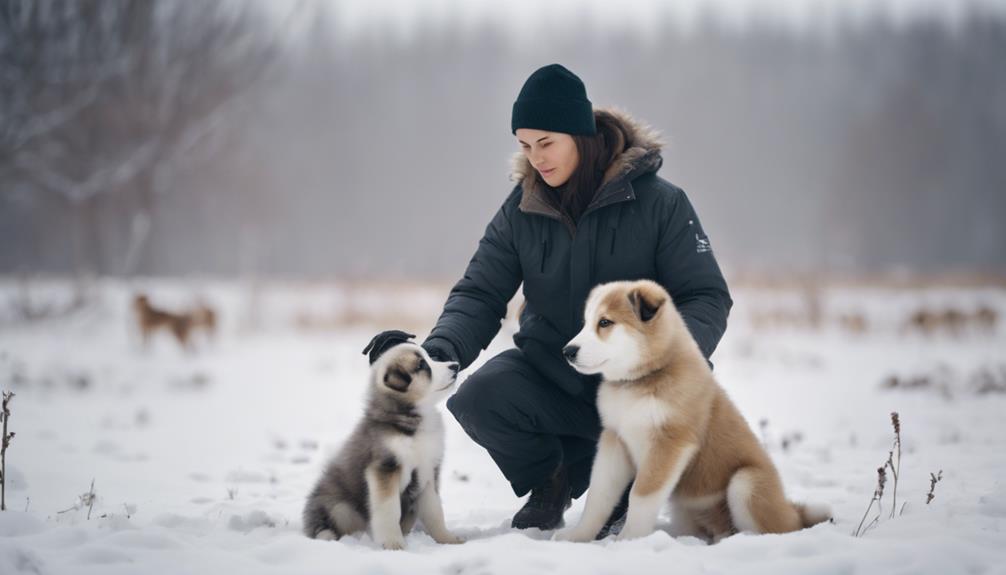
To effectively train and care for the American Tundra Shepherd, utilize positive reinforcement techniques that capitalize on their intelligence and loyalty. These dogs thrive on mental stimulation, requiring interactive games and tasks to maintain their mental well-being. Additionally, meeting their physical exercise needs through regular walks, jogs, and opportunities to run is crucial for their overall health and happiness. Ensuring they are fed a high-quality diet rich in protein and fat supports their energy levels and muscular build. Consistent and patient training methods, void of punishment or force, are essential for developing a well-behaved and well-adjusted American Tundra Shepherd.
- Engage in interactive games and tasks for mental stimulation.
- Provide regular physical exercise such as walks, jogs, and running opportunities.
- Feed a high-quality diet rich in protein and fat.
- Utilize positive reinforcement techniques for training.
- Consistently and patiently train your American Tundra Shepherd for optimal behavior and adjustment.
Frequently Asked Questions
Are American Tundra Shepherds Hypoallergenic?
American Tundra Shepherds are not hypoallergenic. Their coats shed moderately, requiring regular grooming to minimize allergens. Consider breeders carefully for health concerns. Training and socialization are crucial. Adequate exercise, playtime, and a balanced diet are essential for their well-being.
How Well Do American Tundra Shepherds Get Along With Other Pets in the Household?
American Tundra Shepherds generally get along well with other pets in the household. Proper socialization, training techniques, and supervision are key in ensuring harmonious pet compatibility. Introducing new pets gradually and managing conflicts effectively can help create a peaceful environment.
Do American Tundra Shepherds Have a Strong Prey Drive?
When considering the prey drive of American Tundra Shepherds, it's crucial to address their hunting instinct. Behavioral training, socialization, and exercise play key roles in managing potential prey aggression. Environmental enrichment, obedience commands, and mental stimulation are vital for recall training and reducing prey drive.
How Much Exercise Does an American Tundra Shepherd Require on a Daily Basis?
To ensure the optimal well-being of an American Tundra Shepherd, daily exercise routines are crucial. They require vigorous physical activities, mental stimulation, and ample playtime. Obedience training, socialization, and regular outdoor activities help manage their high energy levels.
Are American Tundra Shepherds Prone to Separation Anxiety?
American Tundra Shepherds can be prone to separation anxiety. To address this, focus on separation training, anxiety management, behavioral therapy, mental stimulation, exercise routines, bonding activities, crate training, socialization techniques, interactive toys, and comfort items.
Conclusion
You have now explored the remarkable traits and characteristics of the American Tundra Shepherd, a breed known for its strength, intelligence, and loyalty. As you continue to delve into the world of canine companionship, remember that the journey of understanding and bonding with these majestic creatures is an ongoing adventure. Stay curious, observant, and dedicated in your pursuit of unraveling the mysteries and wonders of the American Tundra Shepherd. Happy exploring!
